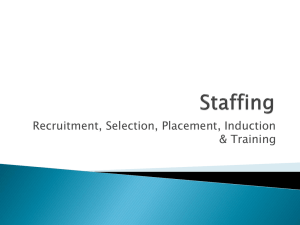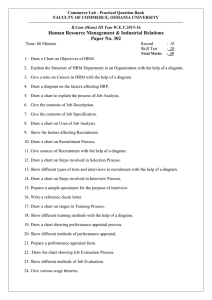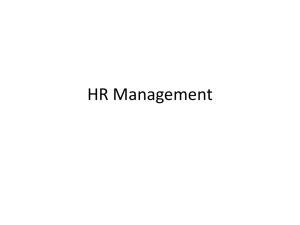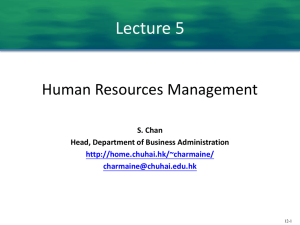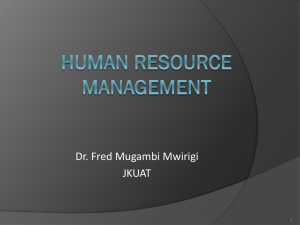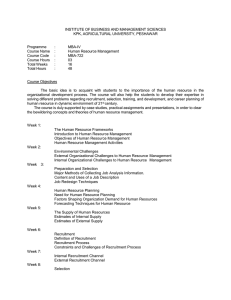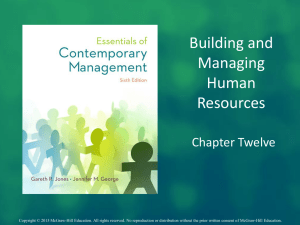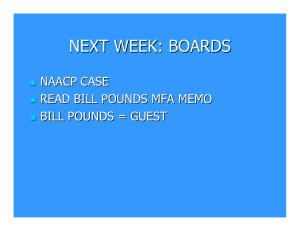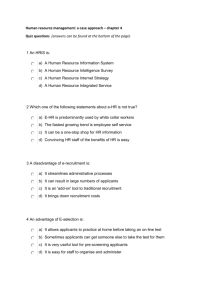Lecture 10
advertisement
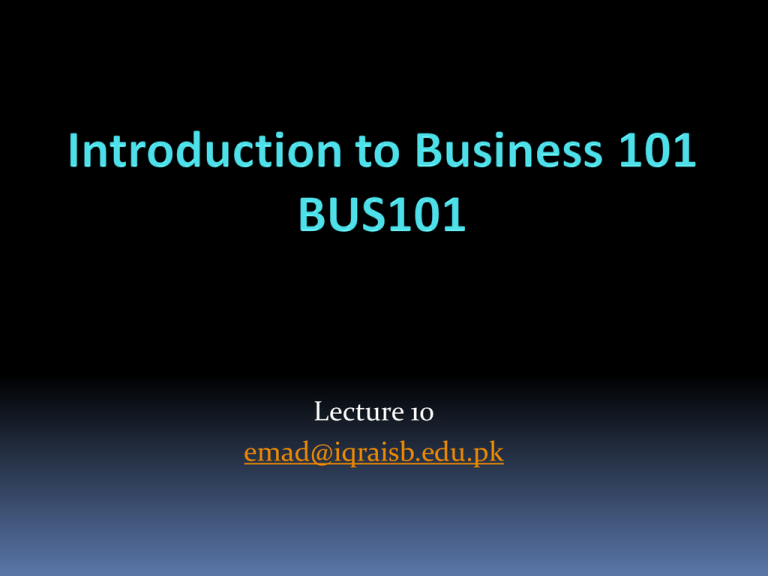
Lecture 10 emad@iqraisb.edu.pk Human Resources • • • Looking after the human side of the business. It is the set of activities that must be done to acquire good employees and build their skills and capabilities so they can work better. Managing human resources to obtain a competitive advantage and superior profitability is a difficult and demanding task for the HRM system. • A company HRM system has five components – – – – – Recruitment & Selection. Training & Development. Performance Appraisal & Feedback. Pay & Benefits. Labour Relations. • Each of the components of the system must be carefully designed and managed for an effective HR policy. Definitions.... • • Performance Appraisal > The task of accurately identifying differences in the level and quality of the work employees do and providing them with feedback that increases their performance levels. Performance Feedback > The communication of performance appraisal information to employees to influence their future performance levels. • Recruitment > The process of identifying and attracting a pool of qualified applicants. • Selection > Creating the set of job and company specific criteria that determines which job applicants are the best match for a particular job and company. • Training & Development > The process through which companies increase their employees work skills and knowledge to improve their performance. • Labour Relations > The process of working with employees, or the unions that represent them, to create work rules and a negotiation process to resolve disputes between them. – Done by establishing rules and practices that are mutually agreed upon and deal with how human resources should be employed & rewarded. • Pay > The monetary rewards, such as wages, bonuses, and salaries associated with a particular job. • Benefits > The monetary rewards, such as paid health care, life insurance, sick and vacation pay and pensions, employees receive because they are a member of a company. • Trade Unions > Organisations that represent the interests of employees who hold similar types of jobs in a particular industry. Human Resources Planning. • • This is the process of forecasting the type & number of employees a company needs to meet the objectives of its business model. Two important tools of human resources planning are: – – Work flow and Job analysis. Workflow Analysis.... • Work-flow analysis is conducted to identify what kinds of jobs will be required to allow each value chain function to perform efficiently & effectively in the future. Job Analysis.... • Job analysis follows on from work-flow analysis. • It is the process of obtaining detailed information about the tasks and responsibilities related to each job in the company. • These analyses yield a more detailed picture of the different tasks in each job and how best to do them. • Job Description & Specification are two documents that are the product of this analysis. • A job description is a list of the specific tasks, duties and responsibilities that make up a particular job. • A job specification is a written list of the required skills, abilities and knowledge needed to do a particular job. • This enables a company to know the type of person that would perform the required duties effectively. • The next step in the process then, is to find qualified applicants. • This is the recruitment part of the process. • Recruitment can be internal or external. • Internal recruitment involves promoting company personnel. • External recruitment involves finding the right people from outside of the company for any vacancies. • What follows is to select the right candidate/s for the work based on four steps. – Screening applicants and cv's/resumes, – Applicant testing and reference checks, – Interviewing, – Making the final selection. • Companies have the obligation to make the recruitment and selection process as fair as possible. • Companies with a good HR policy will usually invest in their employees with training and development programs that increase the skill-set of the employee. • It is done through a training needs analysis that determines who needs which specific kind of training. • Ideally this should be a continuous process throughout the employment period. • Once employees are working for a company, a logical need is for the assessment of work input and output. • This is the area of performance appraisal and feedback. • Which involves testing and ascertaining the level of work done by the employee and then communication it to that employee. • A necessary control feature to determine performance. • Assessing performance is on the basis of certain measures that contain criteria for the analysis of company performance. • The appropriate measures must be selected to ensure an increase in the performance of the company. • Pay is used as an incentive for the employee to carry out the functions of the organisation. There are different categories of payment for different categories of work. – Base pay, – Overtime pay, – Bonus pay. • Pay is linked with benefits which are monetary rewards given to members of a company. • Types of benefits include things like paid health care & life insurance. • The categories mentioned earlier are ways of determining levels of pay and benefits for employees. • A pay structure determines the relative pay and benefits received by employees doing different types of jobs at different levels in an organisation. • A company's pay level is the amount of pay it gives its employees as compared to other companies in comparable areas. • A trade union are organisations that represent the interests of workers who perform a similar type of job in a particular company or industry. • Collective bargaining is the process through which union representatives and managers negotiate a binding labour agreement or contract over work related issues such as – Pay, – Benefits, – Work rules, – Safety conditions & – Job security.
